
Conclusion of the American Civil War
Encyclopedia
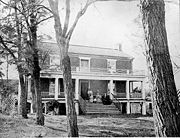
Timeline
A timeline is a way of displaying a list of events in chronological order, sometimes described as a project artifact . It is typically a graphic design showing a long bar labeled with dates alongside itself and events labeled on points where they would have happened.-Uses of timelines:Timelines...
of the conclusion of the American Civil War which includes important battles, skirmishes, raids and other events of 1865. These led to additional Confederate
Confederate States Army
The Confederate States Army was the army of the Confederate States of America while the Confederacy existed during the American Civil War. On February 8, 1861, delegates from the seven Deep South states which had already declared their secession from the United States of America adopted the...
surrenders, key Confederate captures, and disbandments of Confederate military units that occurred after Gen. Robert E. Lee
Robert E. Lee
Robert Edward Lee was a career military officer who is best known for having commanded the Confederate Army of Northern Virginia in the American Civil War....
’s surrender on April 9, 1865.
The fighting of the Eastern Theater
Eastern Theater of the American Civil War
The Eastern Theater of the American Civil War included the states of Virginia, West Virginia, Maryland, and Pennsylvania, the District of Columbia, and the coastal fortifications and seaports of North Carolina...
of the American Civil War
American Civil War
The American Civil War was a civil war fought in the United States of America. In response to the election of Abraham Lincoln as President of the United States, 11 southern slave states declared their secession from the United States and formed the Confederate States of America ; the other 25...
between Lt. Gen.
Lieutenant General (United States)
In the United States Army, the United States Air Force and the United States Marine Corps, lieutenant general is a three-star general officer rank, with the pay grade of O-9. Lieutenant general ranks above major general and below general...
Ulysses S. Grant
Ulysses S. Grant
Ulysses S. Grant was the 18th President of the United States as well as military commander during the Civil War and post-war Reconstruction periods. Under Grant's command, the Union Army defeated the Confederate military and ended the Confederate States of America...
’s Army of the Potomac
Army of the Potomac
The Army of the Potomac was the major Union Army in the Eastern Theater of the American Civil War.-History:The Army of the Potomac was created in 1861, but was then only the size of a corps . Its nucleus was called the Army of Northeastern Virginia, under Brig. Gen...
and Lee's Army of Northern Virginia
Army of Northern Virginia
The Army of Northern Virginia was the primary military force of the Confederate States of America in the Eastern Theater of the American Civil War, as well as the primary command structure of the Department of Northern Virginia. It was most often arrayed against the Union Army of the Potomac...
was reported considerably more often in the newspapers than the battles of the Western Theater
Western Theater of the American Civil War
This article presents an overview of major military and naval operations in the Western Theater of the American Civil War.-Theater of operations:...
. Reporting of the Eastern Theater skirmishes largely dominated the newspapers as the Appomattox Campaign
Appomattox Campaign
The Appomattox Campaign was a series of battles fought March 29 – April 9, 1865, in Virginia that culminated in the surrender of Confederate General Robert E...
developed.
Lee’s army fought a series of battles in the Appomattox Campaign against Grant that ultimately stretched thin his lines of defense. Lee's extended lines were mostly on small sections of thirty miles of strongholds around Richmond
Richmond, Virginia
Richmond is the capital of the Commonwealth of Virginia, in the United States. It is an independent city and not part of any county. Richmond is the center of the Richmond Metropolitan Statistical Area and the Greater Richmond area...
and Petersburg, Virginia
Petersburg, Virginia
Petersburg is an independent city in Virginia, United States located on the Appomattox River and south of the state capital city of Richmond. The city's population was 32,420 as of 2010, predominantly of African-American ethnicity...
. His troops ultimately became exhausted defending this line because they were thinned out too much. Grant then took advantage of the situation and launched attacks on this thirty mile and poorly defended front. This ultimately led to the surrender of Lee and the Army of Northern Virginia at Appomattox
Appomattox Court House National Historical Park
The Appomattox Court House National Historical Park is a National Historical Park of original and reconstructed nineteenth century buildings. It was signed into law August 3, 1935. The village was made a national monument in 1940 and a national historical park in 1954...
.
The Army of Northern Virginia surrendered on April 9 around noon followed by Gen. St. John Richardson Liddell's troops some 6 hours later. Mosby's raiders disbanded on April 21, Gen. Joseph E. Johnston and his various armies surrendered on April 26, the Confederate departments of Alabama, Mississippi and East Louisiana surrendered on May 4, and the Confederate District of the Gulf, commanded by Maj. Gen. Dabney Herndon Maury
Dabney H. Maury
Dabney Herndon Maury was an officer in the United States Army, instructor at West Point, author of military training books, and a major general in the Confederate States Army during the American Civil War.-Early life:...
, surrendered on May 5. Confederate president Jefferson Davis
Jefferson Davis
Jefferson Finis Davis , also known as Jeff Davis, was an American statesman and leader of the Confederacy during the American Civil War, serving as President for its entire history. He was born in Kentucky to Samuel and Jane Davis...
was captured on May 10 and the Confederate Departments of Florida and South Georgia, commanded by Confederate Maj. Gen. Samuel Jones, surrendered the same day. Thompson's Brigade surrendered on May 11, Confederate forces of North Georgia surrendered on May 12, and Kirby Smith surrendered on May 26 (Officially signed June 2). The last battle of the American Civil War was the Battle of Palmito Ranch
Battle of Palmito Ranch
The Battle of Palmito Ranch, also known as the Battle of Palmito Hill and the Battle of Palmetto Ranch, was fought on May 12–13, 1865, during the American Civil War. It was the last major clash of arms in the war...
in Texas on May 12 and 13. The last significant Confederate active force to surrender was the Confederate allied Cherokee Brig. Gen. Stand Watie
Stand Watie
Stand Watie , also known as Standhope Uwatie, Degataga , meaning “stand firm”), and Isaac S. Watie, was a leader of the Cherokee Nation and a brigadier general of the Confederate States Army during the American Civil War...
and his Indian soldiers on June 23. The last Confederate surrender occurred on November 6, 1865, when the Confederate warship CSS Shenandoah
CSS Shenandoah
CSS Shenandoah, formerly Sea King, was an iron-framed, teak-planked, full rigged ship, with auxiliary steam power, captained by Commander James Waddell, Confederate States Navy, a North Carolinian with twenty years' service in the United States Navy.During 12½ months of 1864–1865 the ship...
surrendered at Liverpool, England. President Andrew Johnson
Andrew Johnson
Andrew Johnson was the 17th President of the United States . As Vice-President of the United States in 1865, he succeeded Abraham Lincoln following the latter's assassination. Johnson then presided over the initial and contentious Reconstruction era of the United States following the American...
formally declared the end of the war on August 20, 1866.
Surrender of the Army of Northern Virginia (April 9)
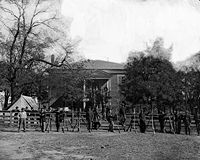
John Brown Gordon
John Brown Gordon was one of Robert E. Lee's most trusted Confederate generals during the American Civil War. After the war, he was a strong opponent of Reconstruction and is thought by some to have been the titular leader of the Ku Klux Klan in Georgia during the late 1860s. A member of the...
commanded its Second Corps
Second Corps, Army of Northern Virginia
The Second Corps of the Army of Northern Virginia was a military organization within the Confederate Army of Northern Virginia during much of the American Civil War. It was officially created and named following the Battle of Sharpsburg in 1862, but comprised units in a corps organization for quite...
. Early in the morning of April 9, Gordon attacked, aiming to break through Federal lines at the Battle of Appomattox Court House, but failed, and the Confederate army was then surrounded. At 8:30 A.M. that morning, Lee requested a meeting with Lt. Gen. Ulysses S. Grant
Ulysses S. Grant
Ulysses S. Grant was the 18th President of the United States as well as military commander during the Civil War and post-war Reconstruction periods. Under Grant's command, the Union Army defeated the Confederate military and ended the Confederate States of America...
to discuss surrendering the Army of Northern Virginia. Shortly after twelve o'clock, Grant's reply reached Lee, and in it Grant said he would accept the surrender of the Confederate army under certain conditions. Lee then rode into the little hamlet of Appomattox Court House, where the Appomattox county court house stood, and waited for Grant's arrival to surrender his army.
Surrender of Gen. St. John Richardson Liddell's troops (April 9)
The Confederates lost the city of Spanish FortSpanish Fort, Alabama
Spanish Fort is a suburb of Mobile, Alabama in Baldwin County, Alabama, United States, located on the eastern shore of Mobile Bay. The 2000 census lists the population of the city as 5,423. It is part of the Daphne-Fairhope-Foley micropolitan area....
in Alabama at the Battle of Spanish Fort
Battle of Spanish Fort
The Battle of Spanish Fort took place from March 27 to April 8, 1865 in Baldwin County, Alabama, as part of the Mobile Campaign of the Western Theater of the American Civil War....
, which took place between March 27 and April 8, 1865 in Baldwin County
Baldwin County, Alabama
-2010:Whereas according to the 2010 U.S. Census Bureau:*85.7% White*9.4% Black*0.7% Native American*0.7% Asian*0.0% Native Hawaiian or Pacific Islander*1.5% Two or more races*4.4% Hispanic or Latino -2000:...
. After losing Spanish Fort, the Confederates went on to lose Fort Blakely to Union forces at the Battle of Fort Blakely
Battle of Fort Blakely
-Sources:**-External links:*...
, between April 2 and April 9, 1865. This is considered to be the last major battle of the American Civil War involving large numbers of United States Colored Troops.
The Battle of Fort Blakely happened six hours after Lee's surrender to Grant at Appomattox. In the course of the battle, Brig. Gen. St. John Richardson Liddell
St. John Richardson Liddell
St. John Richardson Liddell was a prominent Louisiana planter who served as a general in the Confederate States Army during the American Civil War. He was an outspoken proponent of Southern emancipation of slaves...
was captured and surrendered his men. Out of 4,000 soldiers originally, Liddell lost 3,400 that were captured in this battle. About 250 were killed and only some 200 men escaped. The successful Union assault can be attributed in large part to African-American forces.
Union Capture of Columbus, Georgia (Easter Sunday, April 16)
Unaware of Lee's surrender on April 9 and the assassination of President Lincoln on April 14, General James H. WilsonJames H. Wilson
James Harrison Wilson was a United States Army topographic engineer, a Union Army Major General in the American Civil War and later wars, a railroad executive, and author.-Early life and engineering:...
's Raiders
Wilson's Raid
Wilson's Raid was a cavalry operation through Alabama and Georgia in March–April 1865, late in the American Civil War. Brig. Gen. James H. Wilson led his Union Army Cavalry Corps to destroy Southern manufacturing facilities and was opposed unsuccessfully by a much smaller force under ...
continued their march through Alabama into Georgia. On April 16, the Battle of Columbus, Georgia
Battle of Columbus, Georgia
The Battle of Columbus, Georgia , also known as the Battle of Girard, Alabama is widely regarded to be the last battle of the American Civil War...
was fought. This battle - if erroneously
Battle of Palmito Ranch
The Battle of Palmito Ranch, also known as the Battle of Palmito Hill and the Battle of Palmetto Ranch, was fought on May 12–13, 1865, during the American Civil War. It was the last major clash of arms in the war...
- is widely held to be the "last battle of the Civil War." Columbus fell to Wilson's Raid
Wilson's Raid
Wilson's Raid was a cavalry operation through Alabama and Georgia in March–April 1865, late in the American Civil War. Brig. Gen. James H. Wilson led his Union Army Cavalry Corps to destroy Southern manufacturing facilities and was opposed unsuccessfully by a much smaller force under ...
ers about midnight on April 16, and most of its manufacturing capacity was destroyed on the 17th. Confederate Colonel John Stith Pemberton, the inventor of Coca-Cola
Coca-Cola
Coca-Cola is a carbonated soft drink sold in stores, restaurants, and vending machines in more than 200 countries. It is produced by The Coca-Cola Company of Atlanta, Georgia, and is often referred to simply as Coke...
was wounded in this battle which resulted in his obsession with pain-killing formulas, ultimately ending in the recipe for his celebrated drink.
Disbanding of Mosby's Raiders (April 21)
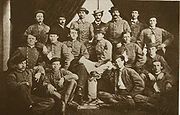
Loudoun Valley
The Loudoun Valley is a small, but historically significant valley in the Blue Ridge Mountains located in Loudoun County in northwestern Virginia in the United States.-Geography:...
area. Under the command of Gen. Robert E. Lee, John S. Mosby
John S. Mosby
John Singleton Mosby , nicknamed the "Gray Ghost", was a Confederate cavalry battalion commander in the American Civil War...
had formed the battalion
Battalion
A battalion is a military unit of around 300–1,200 soldiers usually consisting of between two and seven companies and typically commanded by either a Lieutenant Colonel or a Colonel...
on June 10, 1863, at Rector's Cross Roads near Rectortown, Virginia. Mosby practiced psychological
Psychological warfare
Psychological warfare , or the basic aspects of modern psychological operations , have been known by many other names or terms, including Psy Ops, Political Warfare, “Hearts and Minds,” and Propaganda...
and guerrilla warfare
Guerrilla warfare
Guerrilla warfare is a form of irregular warfare and refers to conflicts in which a small group of combatants including, but not limited to, armed civilians use military tactics, such as ambushes, sabotage, raids, the element of surprise, and extraordinary mobility to harass a larger and...
techniques to disrupt the Union stronghold. Mosby's men never formally surrendered and were disbanded on April 21, 1865, almost two weeks after Lee had surrendered the Army of Northern Virginia to Grant. On the last day of Mosby's striking force, a letter from him was read aloud to his men:
With no formal surrender, however, Union Major General
Major general (United States)
In the United States Army, United States Marine Corps, and United States Air Force, major general is a two-star general-officer rank, with the pay grade of O-8. Major general ranks above brigadier general and below lieutenant general...
Winfield S. Hancock
Winfield Scott Hancock
Winfield Scott Hancock was a career U.S. Army officer and the Democratic nominee for President of the United States in 1880. He served with distinction in the Army for four decades, including service in the Mexican-American War and as a Union general in the American Civil War...
offered a reward of $2,000 for Mosby's capture, later raised to $5,000. On June 17, Mosby surrendered to Maj. Gen. John Gregg
John Irvin Gregg
John Irvin Gregg was a career U.S. Army officer. He fought in the Mexican-American War and during the American Civil War as a general officer in the Union army.-Early life and career:...
in Lynchburg, Virginia
Lynchburg, Virginia
Lynchburg is an independent city in the Commonwealth of Virginia. The population was 75,568 as of 2010. Located in the foothills of the Blue Ridge Mountains along the banks of the James River, Lynchburg is known as the "City of Seven Hills" or "The Hill City." Lynchburg was the only major city in...
.
Surrender of Gen. Joseph E. Johnston and his various armies (April 26)
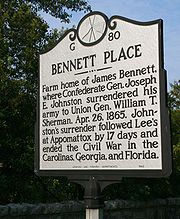
The second and last major stage in the peace making process concluding the American Civil War was the surrender of Gen. Joseph E. Johnston
Joseph E. Johnston
Joseph Eggleston Johnston was a career U.S. Army officer, serving with distinction in the Mexican-American War and Seminole Wars, and was also one of the most senior general officers in the Confederate States Army during the American Civil War...
and his armies to Maj. Gen.
Major general (United States)
In the United States Army, United States Marine Corps, and United States Air Force, major general is a two-star general-officer rank, with the pay grade of O-8. Major general ranks above brigadier general and below lieutenant general...
William T. Sherman
William Tecumseh Sherman
William Tecumseh Sherman was an American soldier, businessman, educator and author. He served as a General in the Union Army during the American Civil War , for which he received recognition for his outstanding command of military strategy as well as criticism for the harshness of the "scorched...
on April 26, 1865, at Bennett Place
Bennett Place
Bennett Place, sometimes known as Bennett Farm, in Durham, North Carolina was the site of the largest surrender of Confederate soldiers ending the American Civil War, on April 26, 1865.-History:...
. Johnston's Army of Tennessee
Army of Tennessee
The Army of Tennessee was the principal Confederate army operating between the Appalachian Mountains and the Mississippi River during the American Civil War. It was formed in late 1862 and fought until the end of the war in 1865, participating in most of the significant battles in the Western Theater...
was among nearly one hundred thousand Confederate soldiers that were surrendered from North Carolina, South Carolina, Georgia, and Florida. The conditions of surrender were in a document called "Terms of a Military Convention" signed by Sherman, Johnston, and Lt. Gen. Ulysses S. Grant
Ulysses S. Grant
Ulysses S. Grant was the 18th President of the United States as well as military commander during the Civil War and post-war Reconstruction periods. Under Grant's command, the Union Army defeated the Confederate military and ended the Confederate States of America...
at Raleigh, North Carolina
Raleigh, North Carolina
Raleigh is the capital and the second largest city in the state of North Carolina as well as the seat of Wake County. Raleigh is known as the "City of Oaks" for its many oak trees. According to the U.S. Census Bureau, the city's 2010 population was 403,892, over an area of , making Raleigh...
.
The first major stage in the peace making process was when Lee's surrender occurred at Appomattox on April 9, 1865. This, coupled with Lincoln's assassination induced Johnston to act, believing: "With such odds against us, without the means of procuring ammunition or repairing arms, without money or credit to provide food, it was impossible to continue the war except as robbers." On April 17 Sherman and Johnston met at Bennett Place, and the following day an armistice was arranged, when terms were discussed and agreed upon. Grant had authorized only the surrender of Johnston's forces, but Sherman exceeded his orders by providing very generous terms. These included: that the warring states be immediately recognized after their leaders signed loyalty oaths; that property and personal rights be returned to the Confederates; the re-establishing the Federal court system; and that a general amnesty
Amnesty
Amnesty is a legislative or executive act by which a state restores those who may have been guilty of an offense against it to the positions of innocent people, without changing the laws defining the offense. It includes more than pardon, in as much as it obliterates all legal remembrance of the...
would be given. On April 24 the authorities in Washington rejected Sherman's proposed terms, and two days later Johnston agreed to the same terms Lee had received previously on April 9.
Gen. Johnston surrendered the following commands under his direction on April 26, 1865: the Department of Tennessee and Georgia; the Army of Tennessee; the Department of South Carolina, Georgia, and Florida; and the Department of North Carolina and Southern Virginia. In doing so, Johnston surrendered to Sherman around 30,000 men. On April 27 his adjutant announced the terms to the Army of Tennessee in General Orders #18, and on May 2 he issued his farewell address to the Army of Tennessee as General Orders #22. The remaining parts of the Florida "Brigade of the West" surrendered with the rest of Johnston’s forces on May 4, 1865, at Greensboro, North Carolina
Greensboro, North Carolina
Greensboro is a city in the U.S. state of North Carolina. It is the third-largest city by population in North Carolina and the largest city in Guilford County and the surrounding Piedmont Triad metropolitan region. According to the 2010 U.S...
.
There is a historical marker at the farm house in Durham, North Carolina, where Johnston surrendered his departments and armies.
Surrender of the Confederate departments of Alabama, Mississippi and East Louisiana regiments (May 4)
.jpg)
Richard Taylor (general)
Richard Taylor was a Confederate general in the American Civil War. He was the son of United States President Zachary Taylor and First Lady Margaret Taylor.-Early life:...
's small force in Alabama was another stage in the process of concluding the American Civil War. The son of former U.S. President Zachary Taylor
Zachary Taylor
Zachary Taylor was the 12th President of the United States and an American military leader. Initially uninterested in politics, Taylor nonetheless ran as a Whig in the 1848 presidential election, defeating Lewis Cass...
, Richard Taylor, commanded the Confederate troops in the Department of Alabama, Mississippi and East Louisiana of about ten thousand troops. On May 4 Taylor's subordinate Col. J.Q. Chenowith surrendered the Department to Union officer Col. John A. Hottenstein.
Mobile, Alabama
Mobile, Alabama
Mobile is the third most populous city in the Southern US state of Alabama and is the county seat of Mobile County. It is located on the Mobile River and the central Gulf Coast of the United States. The population within the city limits was 195,111 during the 2010 census. It is the largest...
, had fallen to Union control on April 12, 1865. Reports reached Taylor of the meeting between Johnston and Sherman about the terms of Johnston's surrender of his armies. Taylor agreed to meet with Maj. Gen. Edward R. S. Canby for a conference north of Mobile, and they settled on a 48 hour's truce on April 30. Taylor agreed to a surrender after this time elapsed, which he did on May 4 at Citronelle, Alabama
Citronelle, Alabama
Citronelle is a city in Mobile County, Alabama, United States. At the 2000 census the population was 3,659. It is included in the Mobile metropolitan statistical area.-History:This was long part of the territory of thousands of years of indigenous peoples...
.
Lt. Gen. Nathan Bedford Forrest
Nathan Bedford Forrest
Nathan Bedford Forrest was a lieutenant general in the Confederate Army during the American Civil War. He is remembered both as a self-educated, innovative cavalry leader during the war and as a leading southern advocate in the postwar years...
surrendered on May 9 at Gainesville, Alabama
Gainesville, Alabama
Gainesville is a town in Sumter County, Alabama, United States. At the 2000 census the population was 220.-Geography:Gainesville is located at .According to the U.S. Census Bureau, the town has a total area of , all of it land....
. His troops were included with Taylor's. The terms stated that Taylor could retain control of the railway and river steamers to be able to get his men as near as possible to their homes. Taylor stayed in Meridian, Mississippi
Meridian, Mississippi
Meridian is the county seat of Lauderdale County, Mississippi. It is the sixth largest city in the state and the principal city of the Meridian, Mississippi Micropolitan Statistical Area...
, until the last man was sent on his way. He was paroled May 13 and then went to Mobile to join Canby. Canby took him to his home in New Orleans by boat.
Surrender of the Confederate District of the Gulf (May 5)
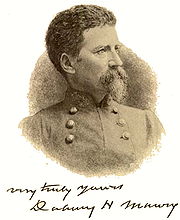
Dabney H. Maury
Dabney Herndon Maury was an officer in the United States Army, instructor at West Point, author of military training books, and a major general in the Confederate States Army during the American Civil War.-Early life:...
. On April 12 Maury retreated with his troops after the two major Confederate forts of Spanish Fort and Fort Blakely were lost to the Union forces. He declared Mobile, Alabama, an open city
Open city
In war, in the event of the imminent capture of a city, the government/military structure of the nation that controls the city will sometimes declare it an open city, thus announcing that they have abandoned all defensive efforts....
after these battles. Maury went to Meridian, Mississippi
Meridian, Mississippi
Meridian is the county seat of Lauderdale County, Mississippi. It is the sixth largest city in the state and the principal city of the Meridian, Mississippi Micropolitan Statistical Area...
, with his remaining men. He wanted to join the remains of the Army of Tennessee
Army of Tennessee
The Army of Tennessee was the principal Confederate army operating between the Appalachian Mountains and the Mississippi River during the American Civil War. It was formed in late 1862 and fought until the end of the war in 1865, participating in most of the significant battles in the Western Theater...
in North Carolina. However, hearing of Johnston's surrender to Sherman on April 26 he soon ran out of options. Ultimately Maury surrendered Mobile's military infantry soldiers and artillery of about four thousand men to the Union army on May 5 at Citronelle, Alabama
Citronelle, Alabama
Citronelle is a city in Mobile County, Alabama, United States. At the 2000 census the population was 3,659. It is included in the Mobile metropolitan statistical area.-History:This was long part of the territory of thousands of years of indigenous peoples...
. It was the last of the Confederate forces to surrender east of the Mississippi River.
Capture of President Davis (May 10)
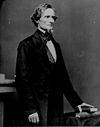
James H. Wilson
James Harrison Wilson was a United States Army topographic engineer, a Union Army Major General in the American Civil War and later wars, a railroad executive, and author.-Early life and engineering:...
's command, captured Confederate President Jefferson Davis
Jefferson Davis
Jefferson Finis Davis , also known as Jeff Davis, was an American statesman and leader of the Confederacy during the American Civil War, serving as President for its entire history. He was born in Kentucky to Samuel and Jane Davis...
after he fled Richmond, Virginia
Richmond, Virginia
Richmond is the capital of the Commonwealth of Virginia, in the United States. It is an independent city and not part of any county. Richmond is the center of the Richmond Metropolitan Statistical Area and the Greater Richmond area...
, following its evacuation in the early part of April 1865. On May 5, 1865, in Washington, Georgia
Washington, Georgia
Washington is a city in Wilkes County, Georgia, United States. The population was 4,295 at the 2000 census. The city is the county seat of Wilkes County...
, Davis had held the last meeting of his Cabinet. At that time, the Confederate Government was declared dissolved.
The sequence of events that led to Davis' capture began early in May 1865, when the 4th Michigan Cavalry was set up in an encampment of tents at Macon, Georgia
Macon, Georgia
Macon is a city located in central Georgia, US. Founded at the fall line of the Ocmulgee River, it is part of the Macon metropolitan area, and the county seat of Bibb County. A small portion of the city extends into Jones County. Macon is the biggest city in central Georgia...
. The military unit of several battalions was commanded by Lt. Col. Benjamin D. Pritchard
Benjamin D. Pritchard
Benjamin Dudley Pritchard was a United States Army officer, most known for leading the Union cavalry regiment which captured the fugitive Jefferson Davis, President of the Confederate States of America, in the weeks surrounding the close of the American Civil War.-Early life and career:Benjamin...
. On May 7, he was given orders to join many other units searching for the Confederate president. Pritchard's troops scouted through the country along the Ocmulgee River
Ocmulgee River
The Ocmulgee River is a tributary of the Altamaha River, approximately 255 mi long, in the U.S. state of Georgia...
, and by the next day the Michigander
Michigander
Michiganian and Michigander are demonyms for residents of the U.S. state of Michigan. Less common alternatives include Michiganer, Michiganite, Michiganese, and Michigine. There is no "official" term. While previous governors Jennifer Granholm, John Engler, and Jim Blanchard used Michiganian,...
s had come to Hawkinsville, Georgia
Hawkinsville, Georgia
Hawkinsville is a city in Pulaski County, Georgia, United States. The population was 7,487 at the 2010 census. The city is the county seat of Pulaski County.-Geography:Hawkinsville is located at ....
, about fifty miles south of Macon, from where they continued along the river to Abbeville, Georgia
Abbeville, Georgia
Abbeville is a city in Wilcox County, Georgia, United States. The population was 2,908 at the 2010 census. The city is the county seat of Wilcox County.- History :...
. There, Pritchard learned from Lt. Col. Henry Harnden
Henry Harnden
Henry Harnden was an officer in the United States Army during the American Civil War. He led the Wisconsin troops who assisted a Michigan military company in the capture of Jefferson Davis.-Biography:...
that his First Wisconsin Cavalry was hot on Davis's trail. After a meeting between the two colonels, Harnden and his men headed off towards Irwinville
Irwinville, Georgia
Irwinville is an unincorporated community in Irwin County, Georgia, United States. It is best known as the site of Jefferson Davis's capture at the end of the Civil War. On May 9, 1865, Jefferson Davis and a small group of officials camped in this pine forest, not knowing that Union cavalry...
, some twenty miles south of their position.
Pritchard received word from local residents that on the night before a party, probably including the Confederate President, had crossed the Ocmulgee River just north of Abbeville. Since there were two roads to Irwindale, one of which had been taken by Harnden and his men, Pritchard decided to take the other, to see if he could capture Davis. He took with him about a hundred and forty men and their horses, while the balance of the Michiganders stayed on the Ocmulgee River near Abbeville. Some seven hours later, at 1 A.M. on May 10, Pritchard arrived at Irwindale. There was no evidence of Harnden's men being there yet.
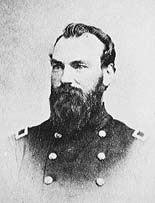
About ten minutes after the surrender, Pritchard heard rapid gunfire to the north. He left Davis and the captured men in the hands of his 21-year-old adjutant
Adjutant
Adjutant is a military rank or appointment. In some armies, including most English-speaking ones, it is an officer who assists a more senior officer, while in other armies, especially Francophone ones, it is an NCO , normally corresponding roughly to a Staff Sergeant or Warrant Officer.An Adjutant...
. Once he had approached the gunfire, he realized it was the 4th Michigan and the 1st Wisconsin shooting at each other with Spencer repeating carbines
Spencer repeating rifle
The Spencer repeating rifle was a manually operated lever-action, repeating rifle fed from a tube magazine with cartridges. It was adopted by the Union Army, especially by the cavalry, during the American Civil War, but did not replace the standard issue muzzle-loading rifled muskets in use at the...
, neither realizing who they were shooting at. Pritchard immediately ordered his men to stop and shouted to the 1st Wisconsin to identify the parties. In the five minute skirmish, the 1st Wisconsin Cavalry had suffered eight men wounded, while the 4th Michigan Cavalry had lost two men killed and one wounded.
Back at camp, Pritchard's adjutant was almost fooled into letting Davis escape by a ruse. Davis's wife had persuaded the adjutant to let her "old mother" go to fetch some water. The adjutant allowed this, and walked away from their tent. Mrs. Davis and a person dressed as an old woman then left the tent to go for the water. One of the other ranking officers noticed the "old woman" was wearing men's riding boots with spurs. Immediately, they were stopped and the woman's overcoat and black head shawl were removed, to reveal Davis himself. The plan of escape thus failed. The Confederate president was subsequently held prisoner for two years in Fort Monroe, Virginia.
Surrender of the Confederate Department of Florida and South Georgia (May 10)
In 1864, Maj. Gen. Samuel Jones commanded the Departments of Florida, South Carolina, and South Georgia, with his headquarters in Pensacola, Florida. His primary orders were to guard the coastal areas of these states and to destroy Union gunboats. He also destroyed all the machinery and sawmills that would be beneficial to the Union armies.In the early part of 1865, Jones was transferred to Tallahassee
Tallahassee, Florida
Tallahassee is the capital of the U.S. state of Florida. It is the county seat and only incorporated municipality in Leon County, and is the 128th largest city in the United States. Tallahassee became the capital of Florida, then the Florida Territory, in 1824. In 2010, the population recorded by...
, soon after Savannah
Savannah, Georgia
Savannah is the largest city and the county seat of Chatham County, in the U.S. state of Georgia. Established in 1733, the city of Savannah was the colonial capital of the Province of Georgia and later the first state capital of Georgia. Today Savannah is an industrial center and an important...
had fallen to Sherman and the Union forces in December 1864. There, Jones headquartered the District of Florida. On May 10, at Tallahassee, he surrendered about eight thousand troops to Brig. Gen. Edward M. McCook
Edward M. McCook
Edward Moody McCook was a lawyer, politician, distinguished Union cavalry general in the American Civil War, American diplomat, and Governor of the Territory of Colorado. He was a member of the famed "Fighting McCook" family of Ohio...
. In military action east of the Mississippi River, the city of Tallahassee was the only Confederate state capital not captured during the Civil War.
Surrender of Thompson's Brigade (May 11)

M. Jeff Thompson
Meriwether Jeff Thompson was a brigadier general in the Missouri State Guard during the American Civil War. He served the Confederate Army as a cavalry commander, and had the unusual distinction of having a ship in the Confederate Navy named for him.-Early life:*Father: Meriwether Thompson b....
commanded Thompson's Brigade. The county seat of Wittsburg, Arkansas (the county seat of Cross County from 1868 through 1886), would witness one of the final acts in the American Civil War. This happened after the collapse of Confederate forces east of the Mississippi. Maj. Gen. Grenville M. Dodge
Grenville M. Dodge
Grenville Mellen Dodge was a Union army officer on the frontier and during the Civil War, a U.S. Congressman, businessman, and railroad executive who helped construct the Transcontinental Railroad....
sent Lt. Col. Charles W. Davis of the 51st Illinois Infantry on April 30, 1865, to Arkansas to seek the surrender of Thompson, commander of Confederate troops in the northeast portion of Arkansas. Davis, arriving at Chalk Bluff (now non-extant) in Clay County, Arkansas
Clay County, Arkansas
Clay County is a county located in the U.S. state of Arkansas. As of 2010, the population was 16,083. The county has two county seats, Corning and Piggott...
, on the St. Francis River
St. Francis River
The Saint Francis River is a tributary of the Mississippi River, about long, in southeastern Missouri and northeastern Arkansas in the United States...
, sent communications to Thompson asking that they have a conference. These two officers met on May 9 to negotiate a surrender.
Thompson requested from Davis two days to work out the details of the surrender with his officers. The Confederates under the command of Thompson agreed to surrender all the troops in the area on May 11. They picked Wittsburg and Jacksonport, Arkansas
Jacksonport, Arkansas
Jacksonport is a town in Jackson County, Arkansas, United States, along the White River at its confluence with the Black River. The population was 235 at the 2000 census.- History :Jacksonport was once an important steamboat stop on the White River...
, as the sites where Thompson's five thousand military troops would gather to receive their paroles. Ultimately Thompson surrendered about seventy-five hundred men all total that were under his command consisting of 1,964 enlisted men with 193 officers paroled at Wittsburg and 4,854 enlisted men with 443 officers paroled at Jacksonport.
Surrender of Confederate forces of North Georgia (May 12)

William T. Wofford
William Tatum Wofford was an officer during the Mexican-American War and a general in the Confederate States Army during the American Civil War.-Early life and career:...
's command took place at Kingston, Georgia
Kingston, Georgia
Kingston is a city in Bartow County, Georgia, United States. The population was 659 at the 2000 census; the 2005 official estimate listed a population of 868.-Geography:Kingston is located at ....
, and was received by Brig. Gen. Henry M. Judah
Henry M. Judah
Henry Moses Judah was a career officer in the United States Army, serving during the Mexican-American War and American Civil War...
on May 12, 1865. There were several letters between the various generals involved in the negotiation of this surrender, including Wofford, Judah, William D. Whipple and Robert S. Granger
Robert S. Granger
Robert Seaman Granger was a career officer in the United States Army, reaching the brevet rank of major general in the Union Army during the American Civil War.-Biography:...
.
Col. Louis Merrill kept the Headquarters Department of the Cumberland in Nashville, Tennessee
Nashville, Tennessee
Nashville is the capital of the U.S. state of Tennessee and the county seat of Davidson County. It is located on the Cumberland River in Davidson County, in the north-central part of the state. The city is a center for the health care, publishing, banking and transportation industries, and is home...
informed and according to a letter he wrote on May 4, 1865, there were about 10,000 soldiers under Wofford's command, "on paper." These consisted of all the Confederate troops in northwestern Georgia, however only about a third could actually be collected as the rest were deserters. From this group there were a number of soldiers that resisted General Wofford's efforts to make them follow his commands.
There is a Georgia historical marker in Kingston, Georgia
Kingston, Georgia
Kingston is a city in Bartow County, Georgia, United States. The population was 659 at the 2000 census; the 2005 official estimate listed a population of 868.-Geography:Kingston is located at ....
, in Bartow County
Bartow County, Georgia
Bartow County is a county located in the U.S. state of Georgia. As of the 2010 census, the population was 100,157. According to the U.S. Census Bureau's July 1, 2009 estimate, the county's explosive growth resulted in a population of 96,217, a 26.5% increase in less than ten years...
at the intersection of West Main Street and Church Street to denote where this surrender took place. It further explains that the Confederate soldiers were given rations after their release.
Disbandment after the Battle at Palmito Ranch (May 13)
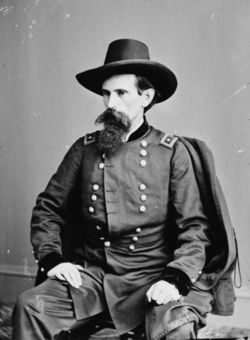
Brownsville, Texas
Brownsville is a city in the southernmost tip of the state of Texas, in the United States. It is located on the northern bank of the Rio Grande, directly north and across the border from Matamoros, Tamaulipas, Mexico. Brownsville is the 16th largest city in the state of Texas with a population of...
, and it was won by the Confederates. The Confederates held the city of Brownsville in the early part of 1865. In January or February Maj. Gen. Lew Wallace
Lew Wallace
Lewis "Lew" Wallace was an American lawyer, Union general in the American Civil War, territorial governor and statesman, politician and author...
was sent by the Union government to Texas. He was sent on an "inspection mission," which in reality was a mission to get Confederate support along the Rio Grande River for the Mexican government, whose president at the time was Benito Juárez
Benito Juárez
Benito Juárez born Benito Pablo Juárez García, was a Mexican lawyer and politician of Zapotec origin from Oaxaca who served five terms as president of Mexico: 1858–1861 as interim, 1861–1865, 1865–1867, 1867–1871 and 1871–1872...
. On March 11 Wallace had a meeting with the two major Confederate commanders of the region, Brig. Gen. James Slaughter and Col. John "Rip" Ford, under the premise that the official purpose was the "rendition of criminals." The real reason was to agree that any fighting in the region would be pointless and negotiate an unofficial indefinite cease fire. Slaughter and Ford, at this point in time, occupied Fort Brown
Fort Brown
Fort Brown was a military post of the United States Army in Texas during the later half of 19th century and the early part of the 20th century.-Early years:...
near Brownsville.
In May Col. Theodore H. Barrett was in temporary command of Union troops at Brazos Santiago Island
Brazos Island
Brazos Island is a barrier island on the Gulf Coast of Texas in the United States, south of the town of South Padre Island.-History:The island is also known as Brazos Santiago Island, a reference to the port of Brazos Santiago, the first Spanish settlement on the island. Later it became the Port...
. He had little military field experience and desired, it is surmised, "to establish for himself some notoriety before the war closed." Barrett knew that an attack on Fort Brown was in violation of orders from headquarters, since the Confederate Army of Northern Virginia already surrendered by Lee at Appomattox on April 9 and many other Confederate forces had surrendered or disbanded by then. In spite of these known facts Barrett decided anyway to go ahead with his plans.
On May 12, Barrett instructed Col. David Branson of the 34th Indiana Veteran Volunteer Infantry to attack the Confederate encampment at Brazos Santiago Depot near Fort Brown. Barrett commanded the 62nd United States Colored Infantry
United States Colored Troops
The United States Colored Troops were regiments of the United States Army during the American Civil War that were composed of African American soldiers. First recruited in 1863, by the end of the Civil War, the men of the 175 regiments of the USCT constituted approximately one-tenth of the Union...
and the 2nd Texas Cavalry, and advanced towards Fort Brown with the intention of reoccupying Brownsville with Union forces thinking they would not encounter any problems, assuming all the Confederates surely had heard of Lee's surrender by this time. To their surprise they encountered Confederates that did not know of Lee's surrender.
A ferocious battle erupted at Palmito Ranch
Battle of Palmito Ranch
The Battle of Palmito Ranch, also known as the Battle of Palmito Hill and the Battle of Palmetto Ranch, was fought on May 12–13, 1865, during the American Civil War. It was the last major clash of arms in the war...
, about 12 miles outside Brownsville. Union forces were outmaneuvered and overrun, and by the next day the Confederate cavalry had all but slaughtered most of the Union troops. The battle was lost by Barrett's Union regiments mainly because the Confederates outnumbered them five to one. In addition, the Confederates cavalry had artillery and infantry, while the Union army consisted only of foot soldiers.
History records show that of the original 300 Union troops that fought at Palmito Ranch, they lost over one third that were killed with several additional captured or seriously injured. Only about 80 managed to escape. From the captives the Confederates learned that Lee surrendered in April and this was the first major step in the peace making process of healing the nation. The Texas Confederates had won the last battle of the war and shortly thereafter disbanded.
Surrender of Kirby Smith (May 26)
Gen. Kirby Smith tried to send reinforcements from his Army of the Trans-MississippiTrans-Mississippi Theater of the American Civil War
The Trans-Mississippi Theater of the American Civil War was the major military and naval operations west of the Mississippi River. The area excluded the states and territories bordering the Pacific Ocean, which formed the Pacific Coast Theater of the American Civil War.The campaign classification...
east of the Mississippi River to relieve Vicksburg, Mississippi
Vicksburg, Mississippi
Vicksburg is a city in Warren County, Mississippi, United States. It is the only city in Warren County. It is located northwest of New Orleans on the Mississippi and Yazoo rivers, and due west of Jackson, the state capital. In 1900, 14,834 people lived in Vicksburg; in 1910, 20,814; in 1920,...
, in the spring of 1864 following the Battle of Mansfield
Battle of Mansfield
The Battle of Mansfield, also known as the Battle of Sabine Crossroads, occurred on April 8, 1864, in De Soto Parish, Louisiana. Confederate forces commanded by Richard Taylor attacked a Union army commanded by Nathaniel Banks a few miles outside the town of Mansfield, near Sabine Crossroads...
and the Battle of Pleasant Hill
Battle of Pleasant Hill
The Battle of Pleasant Hill was fought on April 9, 1864, during the Red River Campaign of the American Civil War, near Pleasant Hill, Louisiana, between Union forces led by Maj. Gen. Nathaniel P. Banks and Confederate forces, led by Maj. Gen...
. This was not practicable due to the Union naval control of the Mississippi River. Smith instead dispatched Maj. Gen. Sterling Price
Sterling Price
Sterling Price was a lawyer, planter, and politician from the U.S. state of Missouri, who served as the 11th Governor of the state from 1853 to 1857. He also served as a United States Army brigadier general during the Mexican-American War, and a Confederate Army major general in the American Civil...
and his cavalry on an invasion of Missouri that was ultimately not successful. Thereafter the war west of the Mississippi River was principally one of small raids. By May 26 a representative of Smith's negotiated and signed surrender documents with a representative of Maj. Gen. Edward Canby
Edward Canby
Edward Richard Sprigg Canby was a career United States Army officer and a Union general in the American Civil War, Reconstruction era, and the Indian Wars...
. Canby in Shreveport, Louisiana
Shreveport, Louisiana
Shreveport is the third largest city in Louisiana. It is the principal city of the fourth largest metropolitan area in the state of Louisiana and is the 109th-largest city in the United States....
, then took custody of Smith's force of 43,000 soldiers when they surrendered, by then the only significant Confederate forces left west of the Mississippi River. With this ended all organized Southern military resistance to the Union forces. Smith signed the surrender papers on June 2 on board the U.S.S. Fort Jackson just outside Galveston Harbor.
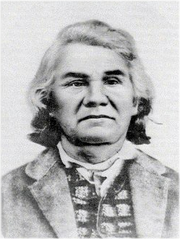
Surrender of Cherokee chief Stand Watie (June 23)
Cherokee Brig. Gen. Stand WatieStand Watie
Stand Watie , also known as Standhope Uwatie, Degataga , meaning “stand firm”), and Isaac S. Watie, was a leader of the Cherokee Nation and a brigadier general of the Confederate States Army during the American Civil War...
commanded the Confederate Indians when he surrendered on June 23. This was the last significant Confederate active force.
Watie formed the Cherokee Mounted Rifles. He was a guerrilla fighter commanding Cherokee
Cherokee
The Cherokee are a Native American people historically settled in the Southeastern United States . Linguistically, they are part of the Iroquoian language family...
, Seminole
Seminole
The Seminole are a Native American people originally of Florida, who now reside primarily in that state and Oklahoma. The Seminole nation emerged in a process of ethnogenesis out of groups of Native Americans, most significantly Creeks from what is now Georgia and Alabama, who settled in Florida in...
, Creek, and Osage
Osage Nation
The Osage Nation is a Native American Siouan-language tribe in the United States that originated in the Ohio River valley in present-day Kentucky. After years of war with invading Iroquois, the Osage migrated west of the Mississippi River to their historic lands in present-day Arkansas, Missouri,...
Indian soldiers. They earned a notorious reputation for their bold and brave fighting. Yearly, Federal troops all over the western United States hunted for Watie, but they never captured him. He surrendered June 23 at Fort Towson
Fort Towson
Fort Towson was a frontier outpost for Frontier Army Quartermasters along the Permanent Indian Frontier located about two miles northeast of the present community of Fort Towson, Oklahoma....
in the Choctaw Nations area at the village of Doaksville (now a ghost town
Ghost town
A ghost town is an abandoned town or city. A town often becomes a ghost town because the economic activity that supported it has failed, or due to natural or human-caused disasters such as floods, government actions, uncontrolled lawlessness, war, or nuclear disasters...
) of the Indian Territory
Indian Territory
The Indian Territory, also known as the Indian Territories and the Indian Country, was land set aside within the United States for the settlement of American Indians...
, being the last Confederate general to surrender in the American Civil War.
Surrender of CSS Shenandoah (November 6)
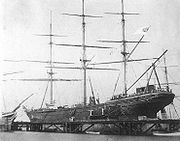
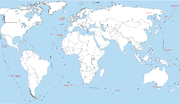
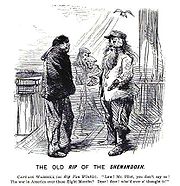
The CSS Shenandoah was commissioned by the Confederacy to interfere with Union shipping to hinder their efforts in the American Civil War. It was a Scottish-built merchant ship originally called the Sea King, secretly purchased by the Confederate forces in 1864. Captain James Waddell
James Iredell Waddell
James Iredell Waddell was an officer in the United States Navy and later in the Confederate States Navy.-Biography:...
commanded the Confederate warship CSS Shenandoah after the Sea King was converted to a warship out in International waters
International waters
The terms international waters or trans-boundary waters apply where any of the following types of bodies of water transcend international boundaries: oceans, large marine ecosystems, enclosed or semi-enclosed regional seas and estuaries, rivers, lakes, groundwater systems , and wetlands.Oceans,...
in October, weeks after leaving England. William Conway Whittle, Waddell's right hand man, was the ship's executive officer.
The Shenandoah then sailing west and north into the South Pacific was in Micronesia at the Island of Ponape
Pohnpei
Not to be confused with Pompeii, the ancient city destroyed by Vesuvius in AD 79.Pohnpei "upon a stone altar " is the name of one of the four states in the Federated States of Micronesia , situated among the Senyavin Islands which are part of the larger Caroline Islands group...
(called Ascension Island by Whittle) when the American Civil War came to terms with the surrender of Lee's Army of Northern Virginia to the Union forces in April 1865.
The Shenandoah continued up to the Aleutians and into the Bering Sea
Bering Sea
The Bering Sea is a marginal sea of the Pacific Ocean. It comprises a deep water basin, which then rises through a narrow slope into the shallower water above the continental shelves....
s. In the Bering Seas she demolished twenty-four non-combantant Union whaling ships. She then traveled north crossing the Arctic Circle
Arctic Circle
The Arctic Circle is one of the five major circles of latitude that mark maps of the Earth. For Epoch 2011, it is the parallel of latitude that runs north of the Equator....
on June 19. Continuing then south along the coast of Alaska
Alaska
Alaska is the largest state in the United States by area. It is situated in the northwest extremity of the North American continent, with Canada to the east, the Arctic Ocean to the north, and the Pacific Ocean to the west and south, with Russia further west across the Bering Strait...
the Shenandoah came upon a fleet of Union ships whaling on June 22. She opened fire continuously, destroying a major portion of the Union whaling fleet. Capt. Waddell took aim at a Union whaling ship and at his signal, the gunner jerked a wrist strap and fired at the fleeing ship Sophia Thornton, being the last two shots of the American Civil War.
From an English barque
Barque
A barque, barc, or bark is a type of sailing vessel with three or more masts.- History of the term :The word barque appears to have come from the Greek word baris, a term for an Egyptian boat. This entered Latin as barca, which gave rise to the Italian barca, Spanish barco, and the French barge and...
, Bark Barracouta, in the process of sailing from San Francisco bound for Liverpool they eventually got word on August 2 that in fact Lee surrendered on April 9, 1865 — some four months earlier. In the log of the Shenandoah was written that day a long entry that started with the words "The darkest day of my life." The captain realized then in his grief that they were taking innocent unarmed Union whaling ships as prizes when the rest of the country had ended hostilities.
He knew that they were now being hunted as pirates and that pirates could be hanged, and so as they traveled south off the coast of South America they stayed far away from any mainland and went into the South Pacific. Waddell immediately then converted the warship
Warship
A warship is a ship that is built and primarily intended for combat. Warships are usually built in a completely different way from merchant ships. As well as being armed, warships are designed to withstand damage and are usually faster and more maneuvrable than merchant ships...
back to a merchant ship (she was known previously as the Sea King). From then on they saw no land for another 17,000 miles until they arrived back in England, logging a total of over 44,000 miles around the world in a year's travel — the only Confederate ship to do a round-the-world trip.
At this point all Waddell wanted to do was surrender the Shenandoah and the proper place to do this, in his mind, was at a European port. He decided on the Port of Liverpool
Port of Liverpool
The Port of Liverpool is the name for the enclosed 7.5 mile dock system that runs from Brunswick Dock in Liverpool to Seaforth Dock, Seaforth, on the east side of the River Mersey and the Birkenhead Docks between Birkenhead and Wallasey on the west side of the river...
. The last Confederate surrender did not occur until November 6, 1865, when the notorious ship under Capt. Waddell's command surrendered at Liverpool to Capt. R.N. Paynter, commander of of the British Royal Navy
Royal Navy
The Royal Navy is the naval warfare service branch of the British Armed Forces. Founded in the 16th century, it is the oldest service branch and is known as the Senior Service...
. The Shenandoah was surrendered by letter to the English Earl Russell
John Russell, 1st Earl Russell
John Russell, 1st Earl Russell, KG, GCMG, PC , known as Lord John Russell before 1861, was an English Whig and Liberal politician who served twice as Prime Minister of the United Kingdom in the mid-19th century....
.
Presidential proclamation ending the war
On August 20, 1866, President Andrew JohnsonAndrew Johnson
Andrew Johnson was the 17th President of the United States . As Vice-President of the United States in 1865, he succeeded Abraham Lincoln following the latter's assassination. Johnson then presided over the initial and contentious Reconstruction era of the United States following the American...
signed a Proclamation—Declaring that Peace, Order, Tranquillity [sic], and Civil Authority Now Exists in and Throughout the Whole of the United States of America. It cited the end of the insurrection in Texas, and declared
See also
- American Civil WarAmerican Civil WarThe American Civil War was a civil war fought in the United States of America. In response to the election of Abraham Lincoln as President of the United States, 11 southern slave states declared their secession from the United States and formed the Confederate States of America ; the other 25...
- Confederate States of AmericaConfederate States of AmericaThe Confederate States of America was a government set up from 1861 to 1865 by 11 Southern slave states of the United States of America that had declared their secession from the U.S...
- Origins of the American Civil WarOrigins of the American Civil WarThe main explanation for the origins of the American Civil War is slavery, especially Southern anger at the attempts by Northern antislavery political forces to block the expansion of slavery into the western territories...
- Turning point of the American Civil WarTurning point of the American Civil WarThere is widespread disagreement over the turning point of the American Civil War. The idea of a turning point is an event after which most observers would agree that the eventual outcome was inevitable. While the Battle of Gettysburg is the most widely cited , there are several other arguable...
- Military of the Confederate States of AmericaMilitary of the Confederate States of AmericaThe Military of the Confederate States of America comprised three branches:* Confederate States Army - The Confederate States Army the land-based military operations...
- Appomattox Court House National Historical ParkAppomattox Court House National Historical ParkThe Appomattox Court House National Historical Park is a National Historical Park of original and reconstructed nineteenth century buildings. It was signed into law August 3, 1935. The village was made a national monument in 1940 and a national historical park in 1954...
Primary sources
- Johnson, Robert Underwood, Battles and Leaders of the Civil War, Yoseloff, 1888
- United States War Department, The War of the Rebellion: a compilation of the official records of the Union and Confederate armies, Government Printing Office, 1902
- Waddell, James Iredell et al., C. S. S. Shenandoah: The Memoirs of Lieutenant Commanding James I. Waddell, Crown Publishers, 1960, Original from the University of Michigan – digitized Dec 5, 2006
- Whittle, William Conway et al., The Voyage of the CSS Shenandoah: A Memorable Cruise, University of Alabama Press, 2005, ISBN 0-8173145-1-2
Secondary sources
- Baldwin, John, Last Flag Down: The Epic Journey of the Last Confederate Warship, Crown Publishers, 2007, ISBN 5-5577608-5-7, Random House, Incorporated, 2007, ISBN 0-7393271-8-6
- Ballard, Michael B., A Long Shadow: Jefferson Davis and the Final Days of the Confederacy, University of Georgia Press, 1997, ISBN 0-8203194-1-4
- Beringer, Richard E. Why the South Lost the Civil War, University of Georgia Press, 1991, ISBN 0-8203139-6-3
- Bradley, Mark L., This Astounding Close: The Road to Bennett Place, UNC Press, 2000, ISBN 0-8078256-5-4
- Catton, BruceBruce CattonCharles Bruce Catton was an American historian and journalist, best known for his books on the American Civil War. Known as a narrative historian, Catton specialized in popular histories that emphasized colorful characters and historical vignettes, in addition to the basic facts, dates, and analyses...
, A Stillness at AppomattoxA Stillness at AppomattoxA Stillness at Appomattox is an award-winning, non-fiction book written by Bruce Catton in 1953. It recounts the American Civil War's final year, describing the campaigns of Ulysses S. Grant in Virginia during 1864 to the end of the war in 1865. It is the final volume of the Army of the Potomac...
, Doubleday 1953, Library of Congress # 53-9982, ISBN 0-385-04451-8 - Comtois, Pierre. "War's Last Battle." America's Civil WarAmerica's Civil WarAmerica's Civil War is a full-color history magazine published bi-monthly which covers the American Civil War. It was established in 1988 by editor Roy Morris Jr. It covers the battles, campaigns, leaders, and common soldiers of the Civil War...
, July 1992 (Vol. 5, No. 2) - Cotham, Edward Terrel, Battle on the Bay: The Civil War Struggle for Galveston, University of Texas Press, 1998, ISBN 0-2927120-5-7
- Cutting, Elisabeth, Jefferson Davis - Political Soldier, Read Books, 2007, ISBN 1-4067233-7-1
- Davis, Burke, The Civil War: Strange & Fascinating Facts, Wings Books, 1960 & 1982, ISBN 0-5173715-1-0
- Davis, Burke, To Appomattox - Nine April Days, 1865, Eastern Acorn Press, 1992, ISBN 0-9159921-7-5
- Eicher, David J.David J. EicherDavid John Eicher is an American editor, writer, and popularizer of astronomy and space. He has been editor-in-chief of Astronomy magazine since 2002...
, The Longest Night: A Military History of the Civil War, Simon & Schuster, 2001, ISBN 0-684-84944-5. - Eicher, John H., and Eicher, David J.David J. EicherDavid John Eicher is an American editor, writer, and popularizer of astronomy and space. He has been editor-in-chief of Astronomy magazine since 2002...
, Civil War High Commands, Stanford University Press, 2001, ISBN 0-8047-3641-3. - Faust, Drew Gilpin, The Dread Void of Uncertainty": Naming the Dead in the American Civil War, Southern Cultures (magazine) – Volume 11, Number 2, University of North Carolina Press, Summer 2005
- Filbert, Preston, The Half Not Told: The Civil War in a Frontier Town, Stackpole Books, 2001, ISBN 0-8117153-6-1
- Gelbert, Doug, Civil War Sites, Memorials, Museums, and Library Collections: A State-by-state Guidebook to Places Open to the Public, McFarland & Co., 1997, ISBN 0-7864031-9-5
- Harrell, Roger Herman' The 2nd North Carolina Cavalry: Spruill's Regiment in the Civil War, McFarland, 2004, ISBN 0-7864177-7-3
- Heidler, David Stephen et al., Encyclopedia Of The American Civil War: A Political, Social, and Military History, W. W. Norton & Company, 2002, ISBN 0-3930475-8-X
- Hoxie, Frederick E., Encyclopedia of North American Indians: Native American History, Culture, and Life from Paleo-Indians to the Present, Houghton Mifflin Harcourt, 1996, ISBN 0-3956692-1-9
- Hunt, Jeffrey William, The Last Battle of the Civil War: Palmetto Ranch, University of Texas Press, 2002, ISBN 0-2927346-1-1,back cover
- Johnson, Clint, Pursuit: The Chase, Capture, Persecution, and Surprising Release of Confederate President Jefferson Davis, Kensington Publishing Corp., 2008, ISBN 0-8065289-0-7
- Katcher, Philip, The Civil War Day by Day: Day by Day, MBI Publishing Company, 2007, ISBN 0-7603286-5-X
- Kennedy, Frances H., The Civil War Battlefield Guide, Houghton Mifflin Company, 1990, ISBN 0-395522-8-2X
- Korn, Jerry, Pursuit to Appomattox: The Last Battles, Time-Life Books, 1987, ISBN 0-8094478-8-6
- Markowitz, Harvey, American Indians: Ready Reference, vol III, Salem Press, 1995, ISBN 0-8935676-0-4
- Marvel, William. "Last Hurrah at Palmetto Ranch." Civil War Times, January 2006 (Vol. XLIV, No. 6)
- McKenna, Robert, The Dictionary of Nautical Literacy, McGraw-Hill Professional, 2003, ISBN 0-0714195-0-0
- Morris, John Wesley, Ghost towns of Oklahoma, University of Oklahoma Press, 1977, ISBN 0-8061142-0-7
- Schooler, Lynn, The Last Shot, HarperCollins, 2006, ISBN 0-0605233-4-4
- Sheehan-Dean, Aaron, Struggle for a Vast Future: The American Civil War, Osprey Publishing, 2007, ISBN 1-8460321-3-X
- Snow, William P., Lee and His Generals, Gramercy Books, 1867, ISBN 0-517-38109-5.
- Sutherland, Jonathan, African Americans at War: An Encyclopedia, ABC-CLIO, 2004, ISBN 1-5760774-6-2
- Thomsen, Brian, Blue & Gray at Sea: Naval Memoirs of the Civil War, Macmillan, 2004, ISBN 0-7653089-6-7
- Tidwell, William A., April '65: Confederate Covert Action in the American Civil War, Kent State University Press, 1995, ISBN 0-8733851-5-2
- Van Doren, Charles Lincoln et al., Webster's Guide to American History: A Chronological, Geographical, and Biographical Survey and Compendium, Merriam-Webster, 1971, ISBN 0-8777908-1-7
- Wead, Doug, All the Presidents' Children: Triumph and Tragedy in the Lives of America's First Families, Simon and Schuster, 2004, ISBN 0-7434463-3-X
- Weigley, Russel F., A Great Civil War: A Military and Political History, 1861-1865, Indiana University Press, 2000, ISBN 0-2533373-8-0
- Wert, Jeffry D.Jeffry D. WertJeffry D. Wert is an American historian and author specializing in the American Civil War. He has written several books on the subject, which have been published in multiple languages and countries.-Bibliography:...
, Mosby's Rangers, Simon and Schuster, 1991, ISBN 0-6717474-5-2 - Wright, Mike, What They Didn't Teach You about the Civil War, Presido, 1996, ISBN 0-8914159-6-3
Further reading
- Andrews, J. Cutler, The North Reports the Civil War, University of Pittsburgh Press, 1955
- Badeau, Adam, Grant in Peace: From Appomattox to Mount McGregor; a Personal Memoir, S.S. Scranton & Company, 1887
- Beatie, Russel H., The Army of the Potomac, Basic Books, 2002, ISBN 0-3068114-1-3
- Boykin, Edward M., The Falling Flag: Evacuation of Richmond, Retreat and Surrender at Appomattox, E.T. Hale, 1874
- Bradford, Ned, Battles and Leaders of the Civil War, Gramercy Books, 1988, ISBN 0-5172982-0-1
- Chaffin, Tom, Sea of Gray: The Around-the-World Odyssey of the Confederate Raider Shenandoah, Hill and Wang/Farrar, Straus and Giroux, 2007, ISBN 0-8090850-4-6
- Crotty, Daniel G., Four Years Campaigning in the Army of the Potomac, Dygert Brothers and Company, 1874
- Catton, Bruce, This Hallowed Ground: The Story of the Union Side of the Civil War, Doubleday 1953, Library of Congress # 56-5960, ISBN 18532669-6-5
- Coombe, Jack D., Gunfire Around the Gulf: The Last Major Naval Campaigns of the Civil War, Bantam Books, 1999, ISBN 0-5531073-1-3
- Craven, Avery, The Coming of the Civil War, University of Chicago Press, 1957, ISBN 0-2261189-4-0
- Cunningham, S.A., Confederate Veteran, Confederated Southern Memorial Association et al., 1920
- Davis, Jefferson, The Rise and Fall of the Confederate Government, D. Appleton and Company, 1881
- Dunlop, W. S., Lee's Sharpshooters, Tunnah & Pittard, 1899, ISBN 1-5821861-3-8
- Gills, Mary Louise, It Happened at Appomattox: The Story of an Historic Virginia Village, Dietz Press, 1948, ISBN 0-8751703-8-2
- Kean, Robert Garlick Hill et al., Inside the Confederate Government: The Diary of Robert Garlick Hill Kean, Head of the Bureau of War, Oxford University Press, 1957
- Konstam, Angus et al., Confederate Raider 1861-65, Osprey Publishing, 2003, ISBN 1-8417649-6-5
- Konstam, Angus et al., Confederate Blockade Runner 1861-65, Osprey Publishing, 2004, ISBN 1-8417663-6-4
- Long, Armistead Lindsay, Memoirs of Robert E. Lee: His Military and Personal History, Embracing a Large Amount of Information Hitherto Unpublished, J. M. Stoddart & Company, 1886
- Longstreet, James, From Manassas to Appomattox: Memoirs of the Civil War in America, J.B. Lippincott, 1908
- Marvel, William, A Place Called Appomattox, UNC Press, 2000, ISBN 0-8078256-8-9
- McPherson, James M., Battle Cry of Freedom: The Civil War era, Oxford University Press, 1988
- Morgan, Murray, Confederate Raider in the North Pacific: The Saga of the C. S. S. Shenandoah, 1864-65, Washington State University Press, 1995, ISBN 0-5852070-3-8
- Schooler, Lynn, The Last Shot: The Incredible Story of the C.S.S. Shenandoah and the True Conclusion of the American Civil War, Thorndike Press, 2005, ISBN 0786280794
- Wise, Jennings Cropper, The Long Arm of Lee: The History of the Artillery of the Army of Northern Virginia; with a Brief Account of the Confederate Bureau of Ordinance, J. P. Bell Company, 1915, volume 2

